Foxtails and dogs are a bad combination. Just ask Dr. Jessica Harris, a veterinarian who lives and works in prime foxtail country and has seen firsthand the damage this plant can do to a dog’s body. Integrative veterinarian Dr. Julie Buzby invited Dr. Harris to the blog to share some words of wisdom, including how to recognize foxtails, the signs of foxtails in different locations on a dog’s body, and how to treat and prevent foxtail problems.

As a pet parent, we try to be prepared for things that we know could cause harm to our dogs. For example, we use flea and tick prevention to protect our dogs from external parasites. And we don’t let our dogs eat chocolate or other foods we know are toxic to them.
However, there are also dangers that we don’t think about or may not know about. One such potential danger is a small grass awn known as a foxtail.
If you have lived around foxtails for a long time, you probably know exactly what I am talking about. These seed heads multiply like rabbits and can be very irritating. Plus, the dangers of foxtails are very real.
But not everyone has seen or heard of a foxtail before. If foxtails just started growing in your area, you recently moved to a new house, or you found a new hiking trail, you may be unaware of the hazards they pose for your pup. So let’s dive into what foxtails are and why they are such a danger for our dogs.
What is a foxtail?
A foxtail is the seed head from a grass-like weed. Interestingly, a foxtail plant is actually not one specific plant. Instead, it is the name for a generic group of plants that drop these dangerous seeds. Some of the plants in the Setaria and Alopecurus families are among the most common culprits.
Foxtails are primarily found on the western half of the United States. However, due to their durability and ability to spread easily, foxtails are appearing in new places every year. Unfortunately, they could be coming soon to a location near you. For your dog’s sake, it is important to be on the lookout for them.
If you aren’t sure if there are any foxtails in your area (or at a particular park or trail), I suggest first walking the area without your dog along with you. That way you can examine the plant life around you for foxtail plants.
What do foxtails look like?
In order to check your surroundings for foxtails, you need to know what you are looking for. Foxtails grow easily and do not need a lot of water. They can be found in a variety of places— open fields, lawns, along rivers or lakes, dirt, or dry climates. They can also look very different depending on if the plants are dead and dried out or alive. To help you know what you’re looking for, please check out the photo of a foxtail below.
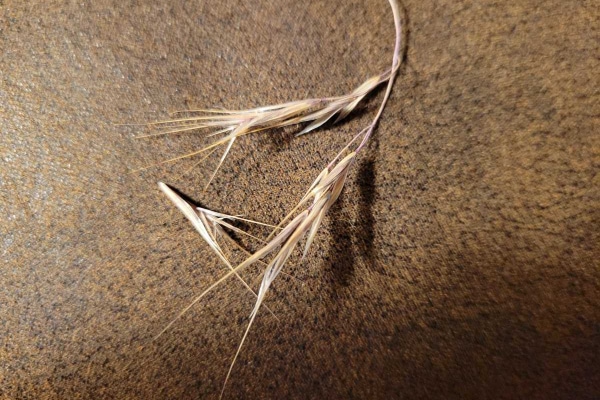
During the spring and early summer, foxtails appear as green grasses. It can be easy to mistake them for lawn grass, so you might be tempted to ignore them or maybe even let them grow. However, as the days get warmer through summer and fall, the plants begin to dry out and die. They become yellow and brown. Sometimes they have a hint of dark purple as well.
At this point, the foxtails are tall grasses with large, and sometimes multiple, seed heads. These seed heads are sharp and barbed. As the plants die, the seeds fall to the ground. In areas where there is a foxtail infestation, there can be so many seeds that is looks like a yellow blanket on the ground.
Why are foxtails dangerous for dogs?
The actual foxtail seed is arrow-shaped, which is a big part of what makes them so dangerous for dogs. As you can see in this picture of a foxtail, the foxtail seed has a sharp end that can easily jab into the skin and create a puncture wound. Because the seed is sleek, it can slide deeper into the tissue without much difficulty. Foxtails can easily penetrate a dog’s skin or burrow into places like the nose, ears, eyes, and paws.
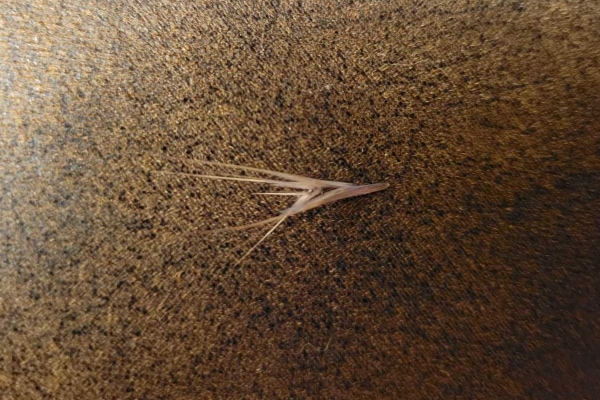
The other end of the foxtail flares out like a barbed feather, which traps the foxtail on a unidirectional path. Once it enters the skin, it can’t easily back out of the hole it made, so it keeps moving forward. This makes it easy for the foxtail to become deeply embedded.
Once a dog has an embedded foxtail, it can damage the tissue around it. The tissue may die or an abscess may form. To further complicate matters, the barbs also make it difficult to remove the foxtail without breaking it.
Can foxtails kill a dog?
In rare and severe cases, the foxtail acts as a migrating foreign body. When left untreated (i.e. not removed), it can travel through your dog’s body. Sometimes it can penetrate vital organs like the lungs. Occasionally it can even migrate to the brain, causing severe side effects like seizures in dogs.
If foxtails migrate like this, they can become impossible to remove. In these severe cases, the foxtails and the damage they cause can be fatal to your dog.
What are the foxtail symptoms for different areas of a dog’s body?
Now that you know how easily foxtails can become embedded, let’s discuss the different locations that they could be found on your dog’s body. Keep in mind that if you find a foxtail in one location, it is a good idea to check your dog for foxtails in other locations.
Foxtails in a dog’s paw
One of the most common locations for foxtails in dogs is the paws. Since dogs like to run through fields or go walking through brush, it makes sense that their paws would encounter foxtails.
If you are lucky enough to catch the foxtail before it embeds in your dog, it might be trapped in the hair between your dog’s toes. This is the time to get rid of it. Otherwise, once it punctures your dog’s paw, it can cause pain and other issues.
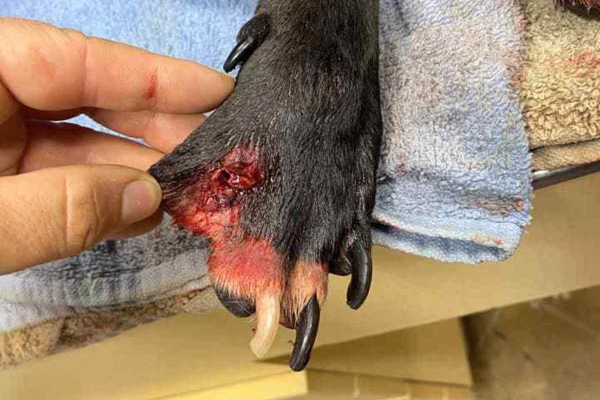
Foxtails like to embed in the toes or the skin in between your dog’s paw pads. If this happens, you might see symptoms including:
- A dog who is limping
- Licking or chewing of the paws
- Itchy dog paws
- Swollen toes or foot
- Red bump(s)
- Discharge from foot
- Open wound on the foot
- Heat felt when touching the foot
If you notice these symptoms, please make an appointment with your vet.
Foxtails in a dog’s ear
In addition to the paw, a dog’s ears are the other most common spot for foxtails to become lodged.
How dogs get foxtails in their ears isn’t always easy to figure out. But, it can happen any time a dog has his or her head in long grasses, such as when sniffing the ground, looking for something to eat, or running, walking, or playing.
Once a foxtail makes contact with your dog’s ear, it is fairly easy for the foxtail to migrate into the ear canal. It is almost like the foxtails fall down into the ear canal tunnel and start to create a pool at the bottom.
This is so common that every time I sedate a dog (especially during foxtail season), I check inside the ears for foxtails. It’s amazing how many of my patients have foxtails in their ears, nose, paws, or coat without their parents realizing it.
Signs of a foxtail in a dog’s ear
However, in other cases it can be very obvious that something like a foxtail is bothering your dog’s ear. The most common sign I see is incessant scratching of the ear—the kind of scratching where the dog might scratch so hard he or she whimpers.

Head tilting is another symptom that makes me suspect a dog has a foxtail in his or her ears. Just like when we have water trapped in our ears, a foxtail in the ear canal is uncomfortable for your dog. This causes him or her to tilt the head, often toward the ear with the foxtail in it.
Other symptoms that could suggest that a foxtail is in your dog’s ear include black or brown debris from the ear, shaking of the head, or blood from the ear.
If you suspect or find a foxtail in your dog’s ear, it is important to contact your vet, and also check your dog’s face for other foxtails.
Foxtails in a dog’s eyes
If a dog’s face has been exposed to foxtails, it is possible for foxtails to end up in the eyes. Sometimes if a foxtail gets in your dog’s eye, it can be obvious and easy to see. For example, it might be sticking out of the eyelid or floating across the eyeball.
However, it also can be hidden as well. It might be below the eyelid or it could have migrated behind the eyeball. In these cases, dogs can develop red, swollen eyes. You also might see your dog pawing at his or her eyes because they are painful and itchy. There can even be increased clear, yellow, or green discharge from the eyes.
If you see signs of a foxtail in your dog’s eyes, don’t delay in contacting your vet. Also, keep in mind that sometimes the eyes and tissue around them can become so swollen, that it begins to affect your dog’s nose as well.
Foxtails in a dog’s nose
Noses are composed of small, tight spaces. This makes them the perfect spot for foxtails to bury into after being inhaled by a dog.
When a foxtail becomes lodged in a dog’s nose, it can be extremely painful. A foxtail in the nose can cause a multitude of symptoms including:
- Pawing at the nose or face
- Discharge from one or both nostrils that can be clear, yellow, or green
- Dog nose bleed
- Swelling around the nose
- Sneezing out a foxtail
And since the nose and eyes are closely related, if there is a foxtail in your dog’s nose, it can affect his or her eyes as well.
If your dog is showing any of these signs, give your vet a call. This is true even if your dog sneezes out a foxtail. There could still be more foxtails in the nose or in other locations on the body, so is best to have your dog seen by a veterinarian.
Foxtails in a dog’s mouth or throat
If your veterinarian is checking your dog’s nose and face for foxtails, he or she will probably check the mouth as well. Unfortunately, it is very common for dogs to decide to eat foxtails as they are wandering through a field. And these not-so-tasty-plants make a very dangerous snack.
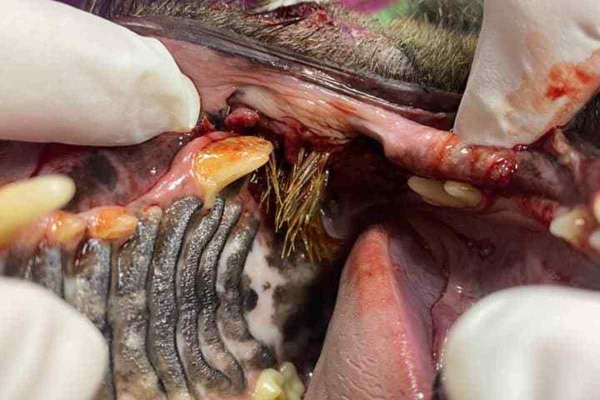
When a foxtail enters your dog’s mouth, it can easily become lodged between the teeth. This can cause food and debris to collect around that spot. As a result, your dog may be more prone to dental disease in dogs and dog tooth abscesses.
Even worse, the foxtail can embed in the gums or cheek tissue. Since the mouth is so full of bacteria, this is a very common place for an abscess to form. I have seen cases where dogs had so many foxtails in their mouth that it actually destroyed the tissue and created a hole in the cheek.
In these scenarios, dogs can be very painful and sensitive when you touch their faces or while eating. Your dog might even stop eating completely. You may also notice blood, a foul smell, or abnormal drainage coming from the mouth. Contact your veterinarian promptly if you notice any of these signs or think your dog ate foxtails.
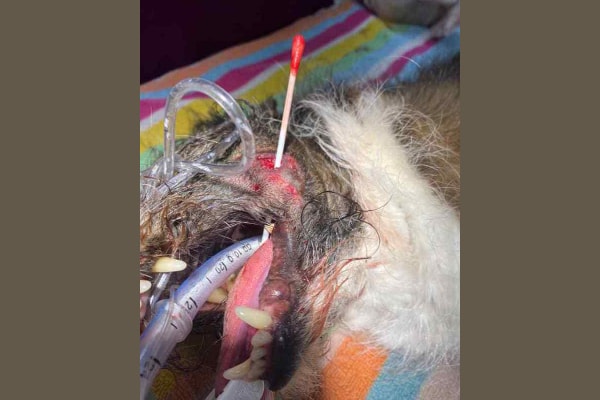
While we are on the topic of foxtails in the mouth, it is important to know that sometimes dogs actually swallow foxtails. And then they may vomit foxtails. I always recommend scheduling a vet visit for dogs who threw up foxtails because it means the dog may be harboring additional foxtails somewhere in the body.
Foxtails acting as a migrating foreign body
If a foxtail is not removed in time, it can migrate to other parts of the body. This is when foxtails become especially dangerous and even deadly.
If a foxtail migrates to the lungs, it can cause severe lung infections. This can lead to a coughing dog or a dog breathing fast or having difficulty breathing. This is an emergency and you should plan on taking your pet in for an emergency vet visit immediately. Occasionally, there have even been situations where a dog loses a lung due to foxtails.
Another dangerous place foxtails migrate to is the dog’s brain. While this is rare, it is very serious. I once saw a client whose young, previously healthy four-year-old dog started having seizures. None of my diagnostics revealed anything except elevated white blood cells, which indicated an infection somewhere in the body.
I sent my client and her dog to a specialist where they performed a CT scan. On the scan, the specialist found a foxtail in the brain that had caused an abscess. Unfortunately, my client had to make the difficult decision to euthanize her dog that day.
Although this is a very rare situation, it can happen. So, any time you suspect your dog has a foxtail embedded somewhere, I always recommend taking him or her to a veterinarian as soon as possible.
How are foxtail problems diagnosed?
As you have probably noticed, the common theme is that seeing symptoms of foxtails (or seeing the foxtails themselves) often warrants a trip to the vet.
But sometimes you (and your vet) may not initially have foxtails very high on the potential diagnosis list. It seems that foxtails are one of those problems that are either very straightforward to diagnose or very challenging.
In cases where dog parents know that their dog runs through foxtail plants or eats foxtails plants, it is easy to know that the dog needs a close exam to look for foxtail seeds. Or, if the vet or dog parent finds a foxtail in the fur, the vet knows to look over the rest of the dog’s body for places where a foxtail might have become embedded.
However, if dog parents have never heard of or seen foxtails before or don’t think they have been anywhere that has foxtails, it isn’t always so straightforward. If it is foxtail season, I closely examine every dog (or outdoor cat) for evidence of foxtails just to be safe. As I mentioned previously, foxtails are good at hiding quickly and in small spaces. This means that I usually like to check every dog’s paws, ears, nose, and mouth for hidden foxtails.
When I am looking, I don’t always find the actual foxtail. Instead, sometimes I find a round puncture wound on the paw or the dog’s abdomen. This can be a telltale sign of a hidden foxtail.
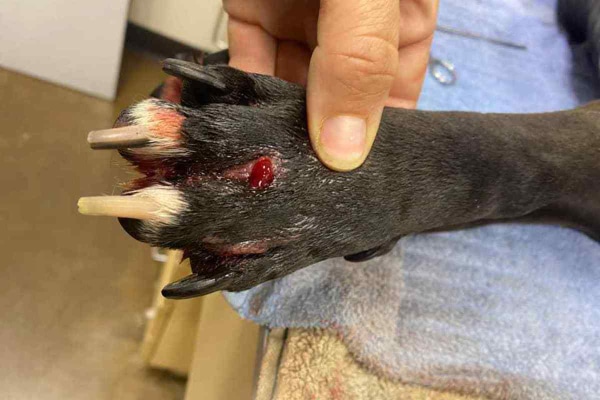
Tracking down foxtails
If your vet finds this type of wound and there is no obvious cause for it, he or she will probably suggest further examining the wound. To do this, your vet will first sedate your dog. Then he or she will use a pair of forceps to look for a “tract,” which is the path that the foxtail took when embedding into your dog. Sometimes the vet will find the foxtail this way.
But other times the process of “fishing” for foxtails isn’t successful. This could be because the foxtail fell out somehow, your dog already pulled out the foxtail, or the foxtail migrated to another location.
If your veterinarian suspects the foxtail is still in the wound or has migrated somewhere else, he or she might recommend diagnostic imaging. Depending on the location of the foxtail, X-rays, ultrasounds, and occasionally CT scans can be useful.
What is the treatment for foxtails?
Whether or not the vet is able to find the foxtail and the location of the foxtail in the body will help dictate treatment.
If your veterinarian suspects or finds a foxtail in your dog’s paw, ear, nose, or eye, he or she will likely recommend sedating or anesthetizing your dog. Sometimes a quick sedation, rather than full general anesthesia, is sufficient, but this depends on the case and location of the foxtail. Once the dog is asleep, your veterinarian will carefully attempt to remove the foxtail.
For dogs with a foxtail in the ear, treatment may involve using an otoscope to visualize the ear canal. Or, if your dog has a foxtail that has made its way deep into the nasal passages, your dog may require rhinoscopy. This procedure involves using a camera to visualize the nasal passages and remove the foxtail from the dog’s nose. In other situations, the vet may be able to remove the foxtail from a wound using forceps.
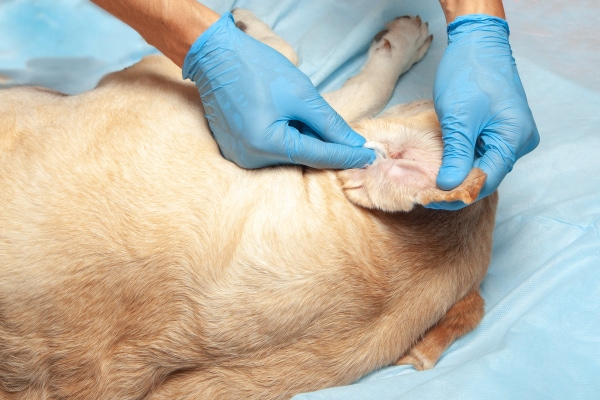
It is important to have your veterinarian remove an embedded foxtail instead of doing it yourself. Foxtails can break inside of the wound, ear, eye, or nose if not removed carefully. If this happens, the foxtail can continue to migrate and cause secondary problems like an abscess.
If the foxtail did create an abscess or large wound, your veterinarian might also recommend antibiotics and pain medication. Sometimes he or she will also place a bandage over the wound to help keep it clean. It is important that you do not allow your dog to lick or chew on the wound or abscess. This could delay healing and further damage the tissue.
Treatment if the vet can’t find the foxtail
If the vet suspects there is a foxtail in a wound but can’t find it, he or she might recommend that you try Epsom salts at home. This treatment can sometimes remove foxtails from a dog’s paw by drawing them out, much the way you may have used Epsom salts to draw a splinter out of your finger.
Dogs don’t know to sit with their paws in Epsom salts like we do, though. So your veterinarian can provide you with instructions and helpful tips on how to successfully do an Epsom salt soak. He or she will also review any safety considerations, such as not allowing your dog to drink the Epsom salt soak water.
As an added benefit, these soaks can also be soothing for your dog. They can clean the wound and help relieve some of the pain associated with the foxtail.
If you are doing Epsom salt soaks at home and the wound is not healing, please take your dog in for another veterinary visit. It is possible that the foxtail moved deeper into your dog’s skin or there is a different cause for the problem.
How do you prevent problems with foxtails?

As you can see, the diagnosis and treatment of foxtails isn’t always that easy, and foxtails can cause some pretty significant issues. For these reasons, the best way to help your dog during foxtail season is preventing foxtails from becoming a problem.
Of course, the easiest way to prevent foxtail issues is by limiting exposure. This means not letting your dog go running through patches of foxtail grasses. If you know your dog eats foxtails, prevention also means monitoring him or her to ensure none are consumed.
Getting rid of foxtails in the area
If foxtails grow on your property, I recommend pulling them out while they are still green (before the seed heads fall on the ground). Or, if the plants do die, you can use a lawn mower to cut them and catch the seeds.
Another option would be to rake as many of the plants and seeds together as you can. I have then had clients use a shop vac to suck up the remaining seeds. Another client once told me that they drag around an old blanket. The seeds will become embedded in the blanket and then it can all just be thrown away.
Using a foxtail hood for dogs
While you can try to limit exposure on your own property, that isn’t always possible when walking or hiking with your dog. Some clients have asked me about using “foxtail hoods” to help keep foxtails out of your dog’s ears, eyes, or face. These mesh hoods go over a dog’s head and are similar to fly masks for horses.
Foxtail hoods might help in some situations where it is impossible to avoid contact with the foxtails. But, they are not a guarantee to protect your dog. And, they actually could act as something for the foxtails to stick to. If you are considering a foxtail hood or other methods of foxtail protection, please talk to your veterinarian. He or she can discuss it with you and help you decide if it is a good fit for your dog.
Regularly checking your dog for foxtails
I know it is not always possible to just avoid all situations where foxtails exist. If you know your dog has possibly encountered these pesky grass awns, then I recommend checking your dog thoroughly, especially if he or she is a senior dog. Older dogs may be at a higher risk of having a foxtail because they don’t groom themselves as well.
Here are the steps I recommend following:
- Comb through your dog’s fur. This is an easy place for foxtails to get caught before embedding into the skin. Start at your dog’s head, work all the way down to the tail, and then check the fur on the legs. Don’t forget to check the belly!
- Closely examine your dog’s paws. Look in between every toe of every paw.
- Next, check inside your dog’s ears. Be careful to not accidentally push a foxtail down into the ear canal if you see one. If it is on the outer ear and completely visible, you can carefully pull it out. Otherwise, contact your vet as they know how to get a foxtail out of a dog’s ear safely.
- Look inside your dog’s mouth (especially if your dog likes to eat grass or other plants).
- Even if you find no foxtails, continue to monitor your dog for the next few hours. Sometimes, foxtails will be hidden in the fur. As your dog walks around and shakes, the foxtails might become loose and easier to see.

I also recommend checking your own shoes and socks for foxtails. If you walked through the plants, the seeds could have stuck to your clothes. When you walk into your house, you might accidentally track them inside.
If you do find any foxtails on you or your dog, you should put them directly in the trash can. You don’t want to remove them from yourself and dog, just for your dog to find them again later.
Surviving foxtail season
Foxtails are a very real danger to dogs in certain areas of the country. To give you some context, a friend of mine, who is also a veterinarian, removed foxtails from 73 different dogs in four months. That is a lot of foxtails! But, that’s not surprising for places with heavy populations of these plants.
There are many reasons that foxtails spell bad news for dogs (and their parents). Foxtails can create a number of issues with your dog’s paws, eyes, nose, face, or body. Plus, they are extremely frustrating, difficult to get rid of, and are showing up in more and more areas of the country.
There is some good news in all of this, though! By being aware of the dangers of foxtails, monitoring your dog, and preventing exposure, you and your furry best friend can survive foxtail season. And should your dog get a foxtail, your veterinarian will be there to help you both through it!
How do you help protect your dog from foxtails?
Please comment below.


Hello, I have been trying to download your free guide for senior dog health care, to no avail. It simply doesn’t download. I checked my email and my “trash” folder, and it isn’t anywhere. Can you help?
I so appreciate your very helpful articles!
Thank you!
Veronique
Human mom of Teddy, 13 yr old Havanese
Hi Veronique,
I am so sorry you are having trouble accessing the health care guide. Were you entering your email into the box in the yellow section at the bottom of the blog article page? I ask because I want to reach out to our team so they can ensure the links are working properly. In the meantime, here is a link to the page where you can sign up for the newsletter and get the free guide as well: https://toegrips.com/newsletter/
Please reach back out to me if this does not work. Best wishes!
it would be helpful in learning to identify these villains if there were pics of a still intact plant(s) amongst other grasses etc, in a field or other likely environment. I believe that perspective would greatly aid ability to identify these nasty culprits before causing our sweet babies pain
Hi Tina,
There are several different species of Foxtail grass that produce these problematic seeds. Here is a link to PennState’s website with more information on how to identify them: https://extension.psu.edu/how-to-tell-foxtail-from-timothy-and-control-it
I hope that helps a bit. Take care and good luck!
I just spent several hours at the vet hospital having a foxtail removed from my dog’s paw. It had entered the pad and migrated to the top of his foot.
They believe they got it all.
My question:
What about those slip-on rubber dog boots? They look like socks and are great for hot pavements and sap.
Will that protect from foxtails?
Hi Rob,
Boots may help prevent foxtails from migrating through your dog’s paws, but boots can cause their own issues if not used properly. Make sure they are not left on too long and there is no moisture buildup inside the boots. Don’t forget to remain vigilant about checking for foxtails as they can cause issues just about anywhere on your dog’s body (ears, mouth, eyes, etc.). Best wishes and good luck!
What happens if the foxtail is not totally taken out of the inner ear by the vet? Can other pieces migrate to the brain? What are symptoms if that is the case other than seizures?
Hi Marcia,
Yes, it is possible for a piece of a foxtail left behind in the ear to migrate to the brain. This would be very rare, but still possible. I am not sure what symptoms you would expect. It all depends on what tissues the foxtail travels through. If you have any concerns that this could be happening to your pup, I highly recommend you contact your vet or a specialist right away.
To be clear, are you talking about foxtail grass, Alopecurus? These look considerably different from foxtail lilies, Eremurus.
Hi Amber,
I am always happy to clarify! Yes, as the article stated we are talking about plants from the Setaria and Alopecurus families. There are pictures in the article as well to help with identification.